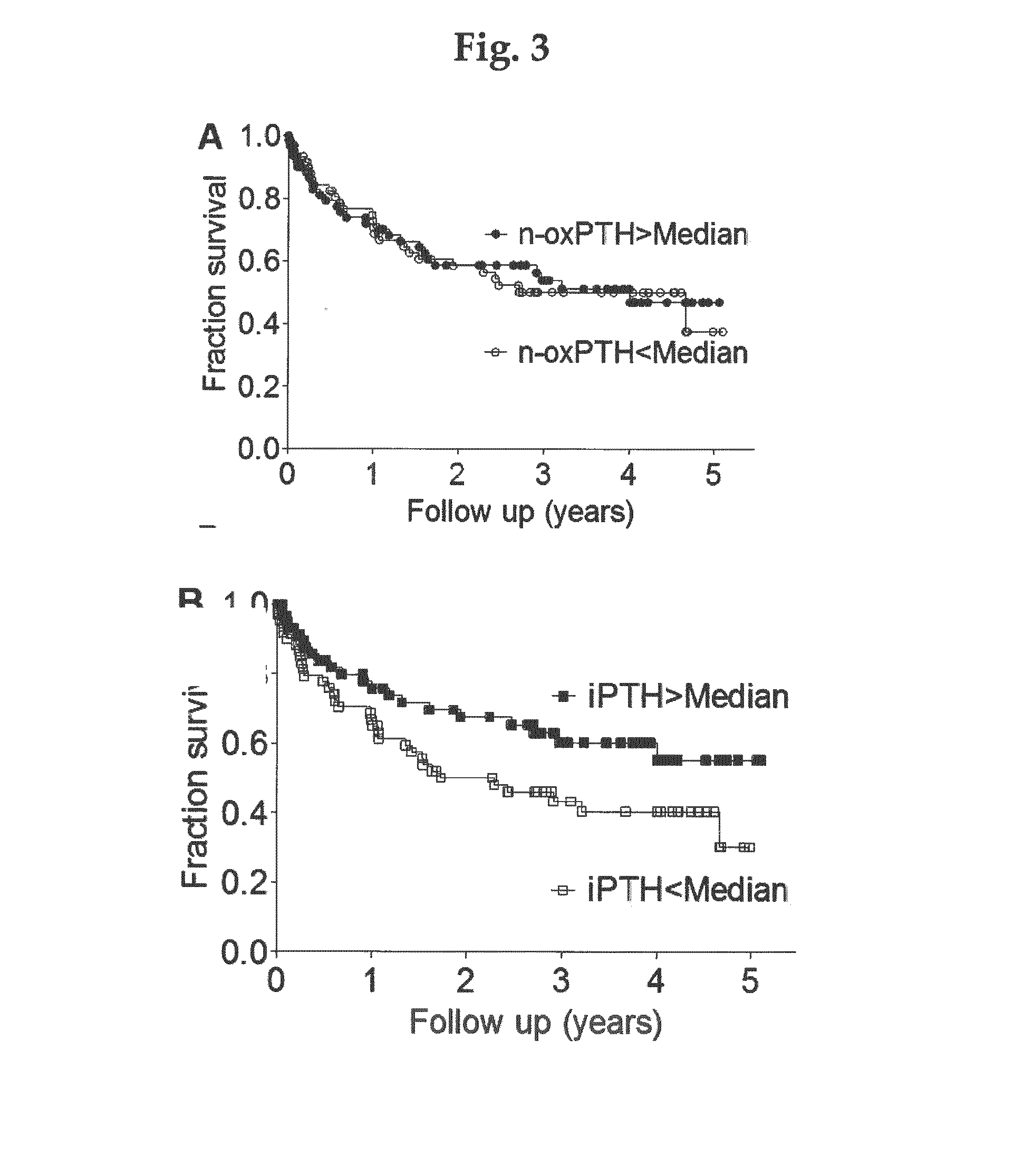Non-oxidized, biological active parathyroid hormone determines mortality in hemodialysis patients
- Summary
- Abstract
- Description
- Claims
- Application Information
AI Technical Summary
Benefits of technology
Problems solved by technology
Method used
Image
Examples
example 1
[0034]PTH-Measurements
[0035]PTH was measured by means of a third-generation electrochemiluminescence PTH immunoassay system both directly (iPTH) and after prior removal of misfolded or oxidized PTH molecules from the samples using monoclonal antibodies raised against the oxidized human PTH (n-oxPTH). Removal of oxidized PTH was performed using an anti-human oxidized PTH monoclonal antibody as described below. The anti-human oxidized PTH monoclonal antibody was immobilized on CNBr-activated Sepharose 4B (GE Healthcare Bio-Sciences, Uppsala, Sweden). Hundred μl aliquot of the slurry as filled in a column (MobiSpinColumn, MoBiTec, Göttingen, Germany) and equilibrated with PBS buffer, pH 7.4. Then, 500 μl of plasma samples were applied on the columns which were incubated mixing end-over-end for 2 h at room temperature, washed with 250 μl of 0.1 M ammonium acetate buffer pH 7.0, followed by a wash with 250 μl of 0.1 M ammonium acetate buffer pH 7.0, containing 20% acetonitrile, and then ...
example 2
[0037]Monoclonal Antibodies Against a Conformation Epitope of Oxidized PTH(aa 1-38)
[0038]Monoclonal antibodies were raised in BALB / c-mice. The mice were immunized with the oxPTH(aa 1-38) thyreoglobulin conjugate at 200 μg for both primary and secondary immunizations with incomplete Freund's (mineral oil only) in the intraperitoneal cavity. Each of the antisera was tested for binding to non-oxidized biotin-hPTH(1-38). To detect antibodies specifically recognizing oxPTH(aa 1-38) peptides, we used the double antibody separation technique and as tracer biotin-oxPTH(aa1-38) labelled with 120 I-streptavidin. After cell fusion and HAT selection, selected hybridomas were screened in the same way, namely for binding to human oxidized PTH(aa 1-84) but not to human PTH(1-84).
[0039]For ultimate characterization of the specificity of the monoclonal antibodies (MAB) and for identification of a monoclonal antibody recognizing a conformation epitope common to oxidized hPTH(1-38) peptides, say commo...
example 3
[0040]Patients
[0041]A prospective cohort study in 340 hemodialysis patients was followed up for 5 years. Our eligibility criteria included all adult prevalent patients on hemodialysis treatment due to end-stage chronic kidney disease stage 5 and presence of informed consent. Informed consent from each patient and ethical approval by the local ethics committee were obtained. Data on dialysis vintage at inclusion and duration of hemodialysis treatment per session were obtained. All of the patients were routinely dialyzed for 4 to 5 hours three times weekly using biocompatible membranes with no dialyser re-use. Blood flow rates were 250 to 300 mL / min, dialysate flow rates were 500 mL / min, dialysate conductivity was 135 mS. Blood pressure was measured before dialysis. Predialysis blood samples were taken at study entry. Blood was collected immediately before the start of the hemodialysis session.
[0042]Clinical and laboratory data included age, gender, medications (use of angiotensin-con...
PUM
 Login to View More
Login to View More Abstract
Description
Claims
Application Information
 Login to View More
Login to View More - R&D
- Intellectual Property
- Life Sciences
- Materials
- Tech Scout
- Unparalleled Data Quality
- Higher Quality Content
- 60% Fewer Hallucinations
Browse by: Latest US Patents, China's latest patents, Technical Efficacy Thesaurus, Application Domain, Technology Topic, Popular Technical Reports.
© 2025 PatSnap. All rights reserved.Legal|Privacy policy|Modern Slavery Act Transparency Statement|Sitemap|About US| Contact US: help@patsnap.com



